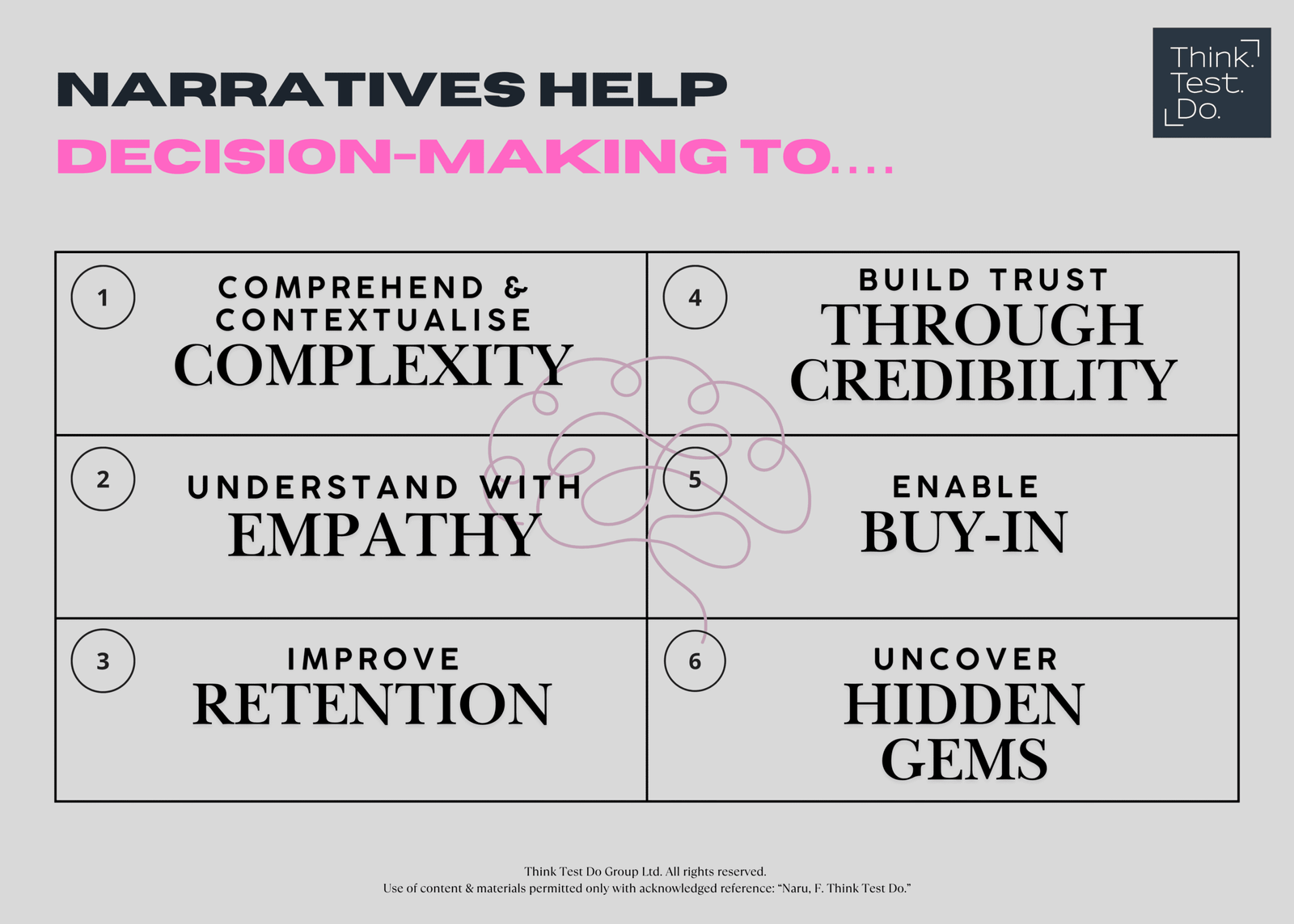Latest
Insights
- Insights
Beyond the Numbers: Why Narratives are so important for Evidence-Based Decision Making (#Leadership)

The appeal of pure objectivity through data and statistics when making decisions is powerful. We attempt to provide evidence-based choices for leaders, driven by facts, figures and info graphs. All in an attempt to present the cold numbers. This is with the aim to avoid bias and ensure optimal outcomes are achieved. However, relying exclusively on quantitative data overlooks an essential aspect of human comprehension and effective decision-making: the impact of narratives and storytelling.
Evidence supplies the facts, but narratives provide the context and meaning. They connect potentially abstract data points with human experiences, converting information into useful insights and enhancing understanding. Overlooking the role of storytelling in evidence-based decision-making may result in decisions that, while technically accurate, do not consider the human aspect necessary for effective implementation and sustained impact.
“Evidence without narratives are just numbers with no meaning!*”
So how do narratives enhance evidence-based decision-making? Here are six ways that story-telling can assist in decision-making.
- To Comprehend and Contextualise Complexity Raw data can be overwhelming and hard to interpret on its own. Narratives provide context by linking data points into an understandable whole and explaining the “why” behind numbers – the story. They reveal relationships and influences, making statistical findings relatable. For example, while data shows a new online educational program boosts test scores, a narrative could highlight how it engages students and achieves the outcome.
- To Understand with Empathy: While evidence is informative, it often lacks emotional depth. Personal stories evoke empathy and help leaders and stakeholders understand the human impact of decisions. For instance, a patient’s story about accessing healthcare can be more impactful than statistics on disparities. This emotional connection is crucial for supporting evidence-based, human-centred interventions.
- Improve Retention: Humans remember stories better than lists of facts or abstract data. The structure and emotion in a story make information more memorable. Presenting evidence within a narrative helps audiences retain and act on key findings, especially when conveying complex information to those without technical expertise and without the use of confusing jargon
- Build Trust through Credibility: Through narratives, evidence gains credibility by showing its real-world relevance. When people see tangible outcomes and understand the stories behind the data, they trust the decision-making process more. Sharing success stories or showing how evidence-based interventions lead to positive change can build confidence and encourage adoption. They can also highlight the limitations and manage expectations.
- Enable Buy-in: Narratives can find common ground amongst diverse opinions and differing stakeholders. They can illustrate shared challenges and benefits, fostering collective understanding and help articulate a unified approach to addressing the issues at hand.
- Uncover Hidden Gems: Valuable insights often come from the stories behind the data. Qualitative narratives from interviews, case studies, and personal accounts can reveal nuances that quantitative data might miss. These stories unveil “golden nuggets” or hidden gems of information that highlight unintended consequences, contextual factors, and individual experiences, This can lead to a better interpretation of evidence and more effective decisions.
Ways to Integrating Narratives into Evidence-Based Practice
The goal is to incorporate narratives into the evidence-based decision-making process without replacing evidence. There are a few methods that can be employed to build the story.
Methods | Description |
Capture and Share “People” Stories | Gather personal stories that illustrate the impact of interventions or capture the challenges being addressed in a personable way. |
Develop Case Studies | Present stories of specific situations to demonstrate the application and outcomes based on evidence of people. |
Visualise the Story | Use visuals, such as infographics and videos, to present data and narratives in an engaging and accessible way. |
Conduct Qualitative Research | Utilise qualitative research methods to collect narrative data that can complement quantitative findings. |
Carry out “Sense-making” Workshops | Organise discussions where stakeholders can check the combined story and create a shared understanding of the connected dots. Testing insights can prevent incorrect diagnostics and actions. |
While evidence is essential for decision-making, narratives provide context, empathy, understanding, and trust. By combining data with compelling stories, we can make more effective, human-centred decisions that resonate with stakeholders and have a meaningful impact. Remember, the human story is often the most compelling evidence.
*Source and Further Reading:
Naru, F. (2024). Behavioral public policy bodies: New developments & lessons. Behavioral Science & Policy, 10(1), 1-17. https://doi.org/10.1177/23794607241285614

